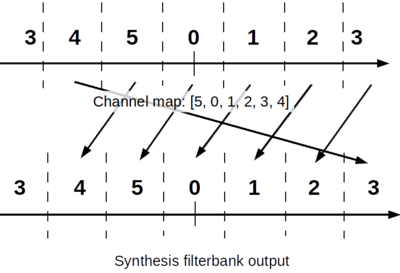Channel Map: Difference between revisions
No edit summary |
No edit summary |
||
| (2 intermediate revisions by the same user not shown) | |||
| Line 2: | Line 2: | ||
[[File:Channel_mapping.png| | [[File:Channel_mapping.png|400px]] | ||
Set the channel map. Channels are numbers as: | |||
<—————- 0 —————–> freq | |||
So output stream 0 comes from channel 0, etc. Setting a new channel map allows the user to specify which channel in frequency he/she wants to got to which output stream. | |||
The map should have the same number of elements as the number of output connections from the block. The minimum value of the map is 0 (for the 0th channel) and the maximum number is N-1 where N is the number of channels. | |||
We specify M as the number of output connections made where M <= N, so only M out of N channels are driven to an output stream. The number of items in the channel map should be at least M long. If there are more channels specified, any value in the map over M-1 will be ignored. If the size of the map is less than M the behavior is unknown (we don’t wish to check every entry into the work function). | |||
This means that if the channelizer is splitting the signal up into N channels but only M channels are specified in the map (where M <= N), then M output streams must be connected and the map and the channel numbers used must be less than N-1. Output channel number can be reused, too. By default, the map is [0...M-1] with M = N. | |||
Latest revision as of 18:38, 4 September 2019
Channel map format for the PFB block. This page needs a rework.
Set the channel map. Channels are numbers as:
<—————- 0 —————–> freq
So output stream 0 comes from channel 0, etc. Setting a new channel map allows the user to specify which channel in frequency he/she wants to got to which output stream.
The map should have the same number of elements as the number of output connections from the block. The minimum value of the map is 0 (for the 0th channel) and the maximum number is N-1 where N is the number of channels.
We specify M as the number of output connections made where M <= N, so only M out of N channels are driven to an output stream. The number of items in the channel map should be at least M long. If there are more channels specified, any value in the map over M-1 will be ignored. If the size of the map is less than M the behavior is unknown (we don’t wish to check every entry into the work function).
This means that if the channelizer is splitting the signal up into N channels but only M channels are specified in the map (where M <= N), then M output streams must be connected and the map and the channel numbers used must be less than N-1. Output channel number can be reused, too. By default, the map is [0...M-1] with M = N.
